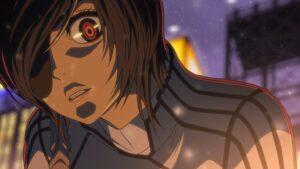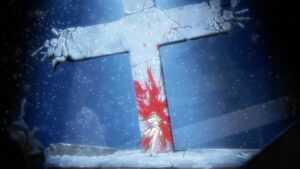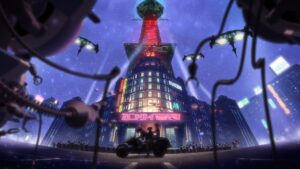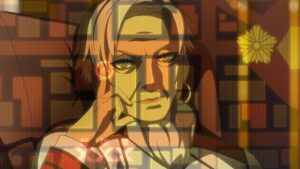Before I get into my thoughts on this episode, I want to note that what we saw this week wasn’t its final form. There’s an additional five minutes of footage that was cut for the TV broadcast, which will be part of the director’s cut on the eventual Blu-ray release. Summaries of the missing content are floating around online, but I haven’t read them – given the excellence of this finale, I may rewatch Akudama Drive at some point, and I want to save a few surprises for myself. Even if you put aside the added footage, this show will benefit from a BD watch more than most, since the censorship will be toned down and its worst-looking moments are likely to be touched up. And who knows, maybe an enterprising sub group will save us from Funimation’s shit translation once the physical release drops. That’s not a likely prospect in the age of simulcasts, but a man can dream, right?
I already slipped the phrase into the paragraph above, but it bears repeating: this was an excellent finale. One of the best of 2020 in my book (though I only completed ~25 shows this year). The action was audacious, the deaths were satisfying, and the final moments were lovingly scored. Even the CG was pretty good – a real feat considering how extensively it was used during Courier’s Eiffel Tower escape sequence. There’s very little for me to criticize here, though if I were to single out the least resonant story element, it would be the continued emphasis on the Execution Department’s corruption. I’ll get into this a bit more in the final series review (which ought to go live before the new year), but the Cliff’s Notes are these: while I admire the attempt at tackling institutional violence, its late-stage introduction and overall simplicity put a dent in its credibility. There were times when it felt as though Akudama Drive was merely appropriating some of the year’s bigger social movements, rather than complimenting or adding to them.
Not everyone will agree with me on that point, which is totally natural. It would be unnatural, on the other hand, to take issue with this episode’s sterling visual direction. The animation didn’t reach the heights of episodes one or six, but the number of striking images generated in this finale was surely higher than in any of the previous installments. I’m talking about Swindler being impaled on a cross, with dangling arms and blooming bloodstains underlining the brutality of her murder as all of Kansai watched in horror. I’m talking about Courier’s brawl with a host of Executioners, framed by the laser beams and metal tentacles of their enforcement robots. I’m talking about his multi-phase duel with the airships in the snowfields outside the city, lit only by their exchanges of fire and the faint dawn’s glow. And of course, I’m referring to Brother and Sister’s journey through the tunnel (the episode’s central motif) and into Shikoku. The final leg of their escape was goosebump-inducingly good, from its quivering piano accompaniment to the gentle snowfall powdering the newly-created ruins on the outskirts of Kansai.
Speaking of the tunnel motif, I think it was a key ingredient in this episode’s emotional payload. We opened with a look into Swindler’s mind after the Shinkansen crash: blackness, then a white light gradually taking the shape of a tunnel’s exit. Notably, it was Sister and Brother’s voices that roused her from this unconsciousness, foreshadowing their use of the same tunnel. We saw it again as Swindler was killed: an illuminated exit in her mind’s eye, this time with the silhouettes of two children in the archway. These scenes were the show’s way of preparing us for the moment when two human offerings crossed into another world, finally discovering a place where they could be free. That we didn’t see how Shikoku looked is beside the point – we know, beyond a shadow of a doubt, that the Akudama’s deaths were not in vain. The smiles on Swindler and Courier’s faces as they died told us what they knew, even in death: their work was done. What a satisfying way to go.
There’s more to say about Akudama Drive (both this episode and the series as a whole) so I’ll be back soon with more thoughts on the show, plus the all-important, not-at-all arbitrary numerical score. Hope everyone is having a happy and safe holiday season – catch you in a few days.





On the bright side regarding Funimation’s subs, the dubbing team behind this one is putting some extra muscle into Akudama Drive’s dub, arguably more than the subs imo with some truly excellent writing and acting in here so far (Legoshi’s dub actor is the one I recognized the most as the Courrier, and Swindler’s dub actor has a long career ahead of her judging by what I heard). Currently, they’re at 3 episodes right now (due to dubbing from home), but I’m looking forward to see how they handle the later material.
FYI, we know what the additional material will cover, they posted it on the website. Details here: https://www.animenewsnetwork.com/bbs/phpBB2/viewtopic.php?p=5262319#5262319
Anyway, I’m looking forward to the director’s cut, but even on its own this was a pretty awesome finale for one of the best shows to come out this year.
As for the show appropriating this years social movements, I’ve seen this criticism before and frankly they all came from North Americans – and I can’t help feeling that some people are projecting their own experiences onto the show. Considering the time necessary to develop an anime likely Akudama Drive’s core story and themes have been already written last year or early this year; even that aside, is not the first anime to touch on institutional oppression, because in Japan that’s a fairly relevant topic pretty much all the time, it’s not like they need Americans doing stuff to feel the need to comment on it.
You raise a good point about the story’s general direction being mapped out during preproduction, and thus prior to a lot of the social unrest in America this year. Being American myself, I do suffer from bias there.
However, I do think that the timing of the executioner/civilian conflict episodes, all of which aired in late November or December, allows for there to have been some influence in the scripting of individual episodes. Police corruption may have been in the cards from the start (“who are the REAL criminals, bro?” was always a question on the show’s mind), but the civilian uprising in particular was haphazardly introduced – a possible symptom of late-stage narrative integration.
I don’t think the civilian uprising storyline was haphazardly introduced at all – quite the opposite, it was pretty well built up as the inevitable escalation of the Kantou vs Kansai plot, and of course the spectacle. (In fact I would have been very surprised if the show didn’t end with some kind of wholescale destruction of the status quo.)
I think this is pretty much a standard structure of stories of this kind. It starts out small and unassuming (“steal this thing”) and then gradually escalates (the “thing” is children, oh wait they’re special immortal children) revealing layers upon layers (the special immortal children have been specifically created for Kantou, oh wait, Kantou is actually just data in the cloud in need of a physical body hence the children, oh wait, creating these children was Kansai’s entire purpose?!!) until it reaches a point where there’s no other way for the status quo to collapse and go out with a bang.
Also, just my opinion but IMO this is not a plotline about police corruption, that’s just another thing that I think a lot of people read into it simply because of the events they experienced in the USA in this year. It’s about how an oppressive system allows for inhuman and cynical treatment of people and how vulnerable it leaves them, but also how it fosters its own potential demise via the discontent and violence it fosters that might erupt any time. The civilians didn’t rise up against the police – at first they were forming vigilante groups against the akudama on the lose, and when the authorities stepped in to stomp it out, that’s when they turned on the police. It really wasn’t a spontaneous righteous uprising.
The civilian uprising wasn’t introduced until episode 9 of 12, and it was motivated by an unverifiable textboard post from Swindler – one of the show’s flimsiest plot elements. Rather than get into the nitty-gritty of the public’s sudden vigilantism, the show ran off to pay homage to The Shining for the second half of the ep. I’d say that qualifies as haphazard introduction.
And how can you say this isn’t a plotline about police corruption? The chief of police was pressured into legalizing the murder of innocent civilians by his top enforcer, and his guilt drove him to suicide in the final episode. That top enforcer was doing the bidding of a cabal of Kanto elites since the early episodes, rather than acting in the public interest. Even the civilians’ fear of the Akudama was later reframed as a lack of confidence that the police would protect them.
Up until episode 9 of 12 the stage of the story was mainly out of the city (or moving outside of/back to the city) and didn’t involve any civilians whatsoever, why would they have introduced it any sooner? At that stage the characters were first trying to get out of town to get the kids to the theme park, then they spent some episodes there, and then some more getting back to the city for the final showdown. There would have been no point in adding anything about an upcoming civilian uprising, especially since at the time civilians had nothing to rise up against. Swindler’s 2ch post was explained in a way that fit both the plot and her character development. And they didn’t get into the nitty-gritty of people’s vigilantism because there was no need: by then it was established that the people of Kansai have a deep-set fear and hatred of akudama. I don’t see the developments as haphazard or inorganic at all (especially considering that Akudama Drive was never pretending to have a well-written, complex story, so some hiccups in writing are perfectly within expectations, see how quickly they handled the whole “oh, Kantou is the cloud” thing).
And re: police corruption, yes, the chief can be seen as corrupt, although considering that Kansai is Kantou’s vassal state, it’s arguable that him following Kantou’s orders may not be corruption as such. But anyway, showing him being under Kantou’s heel, along with the boss lady’s storyline, served the purpose of 1. making it clear that Kansai was completely under Kantou’s power, 2. showing the hypocrisy in the system that demonizes akudama, they they actually support similarly murderous entities, and decide arbitrarily on who is deemed good or bad. It may have featured corrupt people but it wasn’t a commentary on police corruption. Hell, I don’t even agree that anything was “reframed”: people turned against the police because the police’s response to their vigilantism which escalated into riots and extreme violence was trying to stomp it out, which made the people lose trust in them.
I mean, if you’re set on interpreting this plot as being inspired by/commenting on events in the USA in 2020 that’s your opinion and all, more power to you. Neither of us was on the writing team (I assume) so we don’t know what was written when, and how. I’m just saying that I don’t agree, and what you see as haphazard late addition I see as an organic development of the story. Could it have been written better? Maybe, but that’s no reason to assume that a plotline that led to the culmination of the entire series, directly woven into the climax of the story, was added late in a rush when someone on the team was inspired by a sudden and unexpected outbreak of civilian uprisings in the US. (I mean, really – not everything is always about the US.) Especially since the civilian uprising that we have in Akudama is actually quite different from the movement ni the US.
I’m not set on viewing Akudama Drive as an allegory for American social issues or anything like that. It’s only a fraction of the plot that might have been influenced by this year’s events. But even in the (very plausible) scenario where all the scripts were finished before that point, it’s not as though real world police brutality and corruption are exclusive to a single year or nation. A plot like the one on display in Akudama Drive’s final act was surely inspired by real world events, and is thus a commentary on them; science fiction ultimately speaks to the world it comes from, not the world it projects. To say that the show “featured corrupt people but wasn’t a commentary on police corruption” reads like determined blindness.